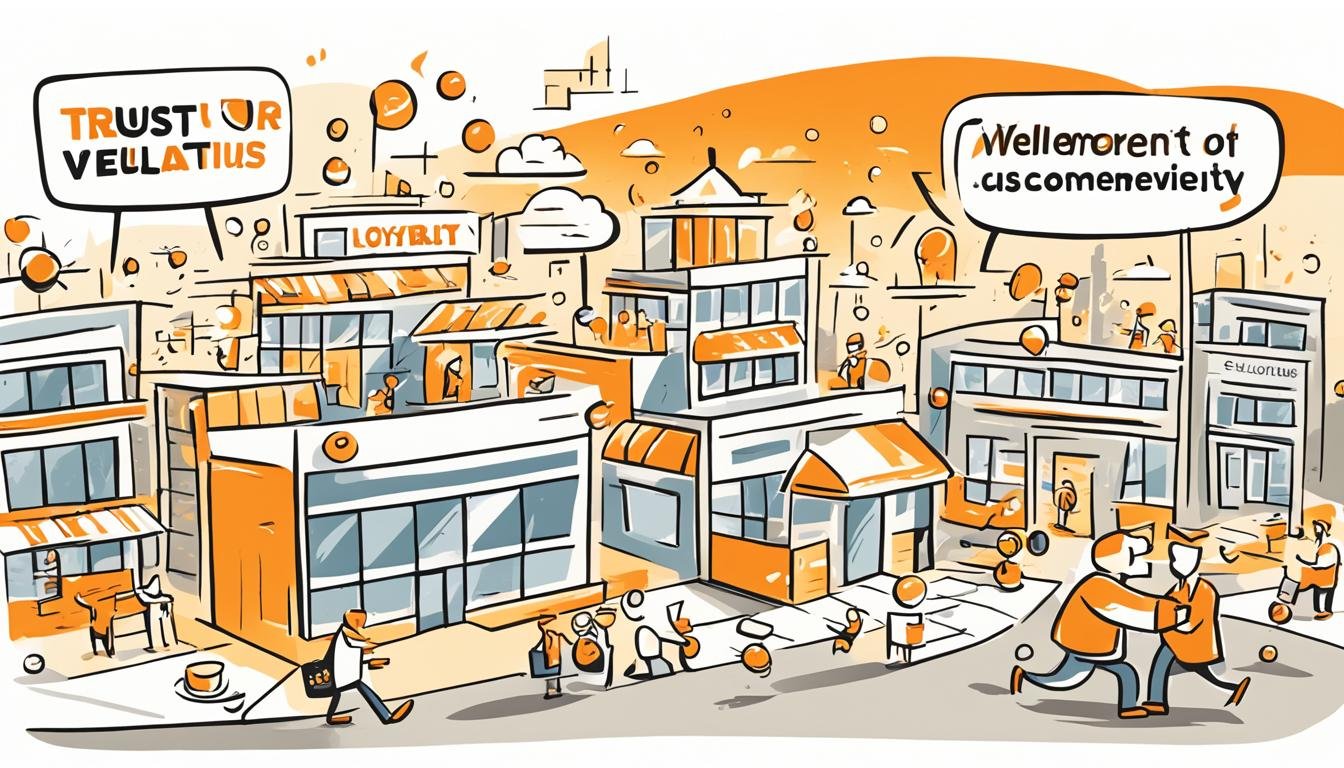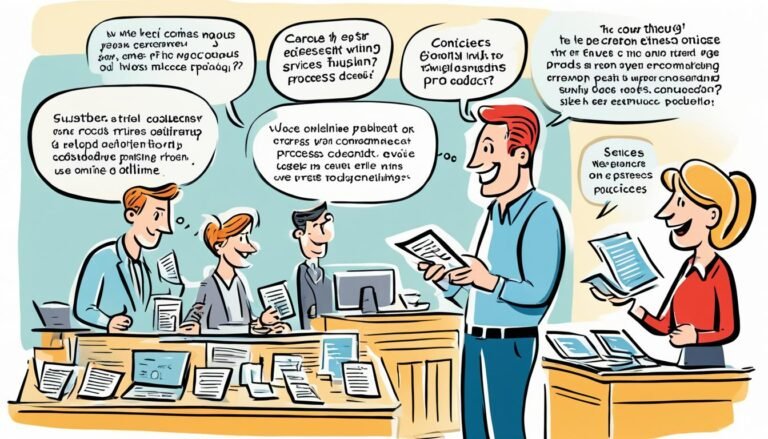The Subscription Economy: Building Customer Loyalty Through Recurring Revenue Models
Companies are turning one-time buyers into loyal customers with the power of subscriptions. The subscription economy is changing how businesses work, helping them keep customers and grow steadily. By using small, regular payments, companies offer ongoing value.
Services like Netflix, Dollar Shave Club, and Adobe Creative Cloud use subscriptions to keep in touch with customers. This approach has grown fast, expected to hit $1.5 trillion by 2025. It shows a move to steady, predictable income for businesses.
As people get used to paying a little at a time, companies must keep up to stay ahead. They need to keep offering value and building a community among their subscribers.
Key Takeaways
- The subscription economy encourages recurring revenue models for sustainable growth.
- Building customer loyalty through monthly interactions is essential.
- Examples span various industries, including SaaS, entertainment, and ecommerce.
- Projections show the subscription market reaching $1.5 trillion by 2025.
- Companies must innovate to consistently provide value and retain subscribers.
Understanding the Subscription Economy
The subscription economy is all about businesses making money through regular payments from customers. This shift means moving from just selling things once to building ongoing relationships with customers. Companies now focus on keeping customers happy to keep making money.
What is the Subscription Economy?
It’s a big change where companies now offer services for a fee instead of just selling products. This change is seen in many areas, like digital streaming and even physical items like razors. By focusing on keeping customers, companies get steady money and can plan better for the future.
These businesses use small, regular payments to make their services cheaper and more appealing. They aim to keep customers for a long time to keep making money. To do well, they work hard to keep customers from leaving.
Historical Context and Evolution
Subscriptions used to be just for things like newspapers and magazines. Now, they cover many digital and physical products. This change shows how people now prefer experiences over owning things. Companies like Spotify and Blue Apron use membership plans to keep customers coming back for more.
Companies with subscription models work hard to keep customers happy and coming back. They use data to make their services better and more personal. This helps keep customers loyal and makes the company more profitable. The subscription economy changes how businesses work, showing the value of keeping customers over just making a sale.
Types of Subscription-Based Business Models
Subscription-based business models offer flexible and customized options for customers. They help create steady income and build strong customer ties.
Subscription Model
Netflix uses a subscription model where customers pay regularly for access over time. This approach is popular across many industries. It ensures a steady income from loyal customers.
Usage-Based Model
Companies like AWS charge customers based on how much they use their services. This suits users who want to pay for what they use. But, it can make it hard for businesses to predict their income, so managing money well is key.
Freemium Model
Spotify uses the freemium model. It offers basic services for free but charges for extra features. This draws in many users and turns some into paying customers, boosting revenue.
Membership Model
Brands like Costco use membership models. Members pay a fee for special benefits and discounts. This creates a loyal customer base and steady income.
Retainer and License Models
Law firms like Baker McKenzie use retainer models, offering ongoing services for a set fee. License models, used by Microsoft and Adobe, also provide steady income. They give customers ongoing value and help build lasting relationships.
Success in subscription-based models comes from matching offerings with what customers want and need. Using strategies like usage-based or innovative services can help. This approach builds strong, ongoing revenue and keeps customers coming back.
Benefits of Recurring Revenue Models
Recurring revenue models offer more than just financial stability. They bring key benefits that are vital for today’s businesses.
Predictability of Revenue
One big plus of recurring revenue is knowing your income is steady. This predictability helps with budgeting and planning. Long-term deals and auto-renewing subscriptions mean steady money coming in. This makes cash flow stable and cuts down on guesswork.
Customer Retention
Keeping customers is key to making more money over time. Great products and top-notch service build loyalty. This loyalty leads to more recurring revenue. Using cross-selling and loyalty programs helps keep customers coming back, making money more predictable.
Increased Cash Flow
Recurring revenue means more cash flowing in. With steady income, managing expenses and investing in growth is easier. Managed service providers, for example, make money through services like security and endpoint management, on a regular basis.
Scalability
Scalability is another big plus. These models let businesses grow without huge cost increases. Digital services like cloud computing can add new customers without big extra costs. A flat fee model helps keep earnings steady while growing your customer base easily.
Recurring revenue models boost customer lifetime value and ensure steady income. These benefits show why more businesses are turning to them for a strong financial future.
Challenges in Implementing Recurring Revenue Models
Businesses moving to recurring revenue models face many hurdles. These models are great for being predictable and building strong customer ties. But, they also bring challenges.
High Customer Service Demand
A big challenge is handling high customer service demand. This model needs ongoing support for billing, subscription changes, and questions. Companies like Amazon Web Services (AWS) and Netflix show the importance of a strong customer service team.
Dealing with lots of recurring transactions and keeping customers happy can raise costs a lot.
Effort in Customer Retention
Keeping customers is key to recurring revenue models. Businesses must work hard to keep customers happy and loyal. This means offering personalized experiences and top-notch service.
For example, Adobe Creative Cloud and Spotify always improve their services to stay ahead and keep customers. Keeping customers and managing price sensitivity takes careful planning and execution to stay strong over time.
Managing Price Sensitivity
Managing price sensitivity is a big challenge. Changes in price can affect how happy customers are and how likely they are to stay. Companies like Netflix and Dollar Shave Club use tiered billing to offer different prices for different customers.
This helps avoid the risks of being seen as too expensive. Such strategies need a good grasp of what the market wants and what customers expect.
In the end, recurring revenue models have many benefits. But, businesses must handle challenges like customer service, keeping customers, and managing prices well to do well in this changing world.
Strategies for Building Customer Loyalty Through Recurring Revenue Models
To succeed with recurring revenue models, businesses must focus on building customer loyalty. This loyalty is key for keeping customers over time and making more money. Important strategies include offering personalized experiences and using customer feedback well.
Personalized Customer Experiences
Offering personalized customer experiences is a great way to keep customers loyal. When businesses tailor their interactions to what customers like, customers feel special. For instance, subscription services can give customers products or content that fits their interests.
This makes customers feel like they’re part of something special. It makes them happier and more loyal to the brand.
Leveraging Customer Feedback
Using customer feedback to make things better is also key. When businesses ask for and use feedback, it shows customers their opinions count. This builds a sense of community and involvement.
It leads to better services and stronger relationships with customers. By letting customers help shape the product, businesses can make customers more loyal and keep them coming back.
Adding a loyalty program can also help keep customers close. Loyalty programs that reward regular purchases keep customers coming back. These programs make the customer experience better and help businesses grow over time.
Examples of Successful Subscription Services
Subscription services have changed many industries. They offer convenience, keep customers coming back, and give curated experiences. This has helped them keep customers and grow revenue. Let’s see how Netflix, Spotify, Blue Apron, and Dollar Shave Club use this model well.
Netflix and Streaming Services
Netflix changed how we watch movies and TV shows. It offers a huge library for a set monthly fee. This lets subscribers stream without extra costs, making for a great experience.
Spotify and Music Streaming
Spotify changed the music world by giving access to millions of songs. It has free and premium plans. Users can pick between ads or no ads. Spotify uses playlists and feedback to make it better for users.
Blue Apron and Meal Kits
Blue Apron makes cooking easy by sending ingredients and recipes to customers. It’s great for busy people and families. This service simplifies meal planning and cooking.
Dollar Shave Club and Personal Care
Dollar Shave Club offers a subscription for personal care items like razors and grooming kits. It sends these items regularly. This keeps customers coming back and loyal.
Innovative Subscription Services Transforming Industries
Today, subscription services are changing many industries, not just software and entertainment. Companies are finding new ways for people to use products and services. This big change shows the power of subscription service innovation.
In education, Coursera and Udemy offer courses for a fee. This makes learning quality available to more people. These platforms show how transformative subscription services can make education more accessible.
In healthcare, One Medical and Teladoc use subscriptions for telehealth services. This lets patients get medical advice and health checks from home. It’s a big change for the healthcare industry.
Tech giants like Adobe, Salesforce, and Microsoft now use subscriptions for their software. This has led to more stable and predictable income. It shows how innovative business models work well in tech.
Subscription models also help keep customers coming back. Companies like Netflix and Spotify keep giving customers what they want. This makes customers happier and keeps them loyal, showing how subscriptions can change industries.
Subscription businesses also get a lot of data on what customers like. They use this data to make their services better. This helps increase the value of each customer and keeps them from leaving. These points show the financial and strategic benefits of subscription services.
Blockchain and cryptocurrencies are also seeing new subscription services. New platforms are offering financial services in a new way. This could be the start of big changes in finance.
In conclusion, innovative business models like subscription services are changing traditional businesses. As companies keep improving these models, we can expect big changes and new opportunities for everyone.
Best Practices for Subscription Business Models
In today’s fast-growing subscription economy, it’s key for businesses to succeed. They must focus on giving consistent value, using data wisely, and being clear about prices. This approach helps keep customers happy and boosts long-term earnings.
Consistent Value Delivery
For customer satisfaction and keeping them around, consistent value delivery is key. Studies reveal that loyal customers spend 67% more than new ones. Subscription businesses need to meet customer needs and justify the cost of recurring payments. Adding features that make life easier and save time, like automated buying, keeps the value coming.
Nearly 97% of top subscription businesses focus on what customers need, cutting down on leaving and building loyalty.
Being flexible, like letting customers pause, cancel, or change subscriptions, also boosts the customer experience. This approach increases happiness and lowers the chance of customers leaving. It’s a big win for subscription success.
Effective Use of Data Analytics
Using data analytics in subscriptions is vital for knowing what customers like and want. Regular checks on customer feedback and metrics like Monthly Recurring Revenue (MRR) spot areas to get better and growth chances. With these insights, companies can tailor their services and make customers feel valued, keeping them coming back.
Subscription services have grown nearly four times faster than the S&P 500 over 11 years. This shows how crucial data-driven choices are in winning and keeping market share in the competitive subscription world.
Transparent Pricing Models
For trust and keeping customers, transparent subscription pricing is key. Being clear about prices, billing, and subscription details sets the right expectations and lowers the chance of dissatisfaction. IBM says nearly 65% of consumers feel closer to companies they subscribe to than those they buy from just once.
Clear and honest pricing builds trust and sets you apart from rivals. In a shaky economy where 80% of consumers opt for cheaper brands, being open can make customers stick with you, even when looking to save money.
Getting new customers can be up to five times pricier than keeping the ones you have, showing the value of clear and customer-focused subscription models.
By following these best practices – consistent value, smart data use, and clear pricing – companies can tackle the subscription economy’s challenges. They build strong customer ties and grow steadily.
Loyalty Program Implementation in Subscription Businesses
Adding loyalty programs to subscription businesses boosts customer retention and strengthens the subscription value. About 68% of people want to join a loyalty program if a brand impresses them with its customer service. By offering rewards, special content, or discounts, companies can build strong customer ties and encourage long-term subscriptions.
Loyalty programs for subscriptions make customers happier. Research shows that 71% of Gen X, 70% of Millennials, 63% of Baby Boomers, and 62% of Gen Z like brands with loyalty programs more. Also, 56% of consumers pay more for a brand they love, even if cheaper options are available. Personalized rewards make customers spend up to 4.3 times more than non-personalized ones.
For startups and small businesses, loyalty programs offer a steady income. Companies using these programs see better retention and more recurring revenue. Personalized offers based on customer data improve the customer experience and increase engagement. These programs give valuable insights into what customers like, helping businesses make smart decisions. But, keeping the program valuable and ensuring data privacy and security are big challenges.
Source Links
- Subscription Business Model
- A guide to subscription revenue models | Stripe
- What is a subscription revenue model and how does it work?
- The Rise of Subscription Models: Redefining Customer Loyalty and Revenue Streams
- What’s a Subscription Business Model & How Does It Work?
- Recurring Revenue Models for SaaS [Explained]
- Maximize Recurring Revenue in Your Business
- Recurring Revenue: Models, Benefits and Why It’s Important
- Recurring revenue models explained | Stripe
- What is Recurring Revenue Business Model? Types, Benefits & Challenges | Zoho Billing
- Recurring revenue models
- How to Leverage 9 Popular Recurring Revenue Business Models
- Subscription Business Model: The Future of Commerce | Recurly
- Maximizing Revenue Stability: Exploring the Benefits of a Recurring Revenue Model
- Subscription Business Model Defined, How It Works, Examples
- 18 Money-Making Subscription Model Business Ideas for Creators | Castos
- 9 Recurring Revenue Businesses Models (2024)
- The Subscription Revolution: Embracing Recurring Revenue in the Modern Business Landscape
- The complete guide to recurring revenue models for eCommerce brands
- Subscription Models: The Key to Recurring Revenue and Customer Retention
- How to Build Recurring Revenue Streams With Digital Products
- Loyalty program implementation: a step-by-step guide
- Loyalty Loophole: How to Design a Subscription Program Customers Can’t Resist
- The Rise of Subscription-Based Loyalty Programs







